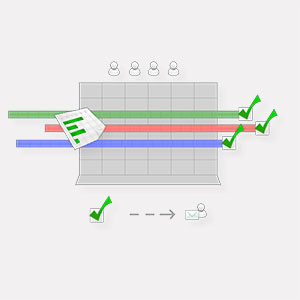Bio
I got a Ph.D. in Information and Systems Engineering from Concordia University. I received my Master of IT in Management Information Systems at Universiti Kebangsaan Malaysia in 2012, and my BSc. degree in Information Technology Engineering from Islamic Azad University in Iran in 2008. I am happily married, and enjoy sharing my life, work as well as study treasures with my husband. I enjoy my time traveling and exploring the unknowns. I am fascinated by diverse culture and life style of different countries where I lived and visited so far. I am also interested in learning languages. I speak Farsi and English fluently and French, German and Spanish in basics.
Current Work
-
2024Present Montreal, Canada

Computer Science Lecturer
-
2023Present Montreal, Canada

Computer Science Lecturer
-
2022Present Montreal, Canada

Computer Science Lecturer
Job Experience
-
2014 2013
-
2014 2012
Research Assistant
-
2010 -
Website Administrator
Noor ICT Co. Tehran, Iran & Islamic Union of Iranian Students Association in Malaysia
-
2012 2007
Project Management Officer
Noor ICT Co. Tehran, Iran
-
2008 2006
ICT Market Researcher
Supreme Council of Information and Communication Technology (SCICT) of Iran
Education
-
PhD2021
Doctoral of Information and System Engineering
Concordia University, Canada
-
MIT2012
Master of IT - Management Information System
National University of Malaysia
-
BSc2008
BSc. Information Technology Engineering
Islamic Azad University, Iran
Honors, Awards & Grants
-
2016 - 2019Vanier Canada Graduate Scholarships (Vanier CGS)NSERC, Government of Canada
www.vanier.gc.ca
The Vanier Canada Graduate Scholarship (Vanier CGS) program is for three years during doctoral studies. It helps Canadian institutions attract highly qualified doctoral students. It considers three equally weighted selection criteria: academic excellence, research potential, and leadership. More information can be found in Concordia University News Portal , Concordia University Graduate School and Concordia CAPSTONE Magazine (Winter 2017 - 2.77 MB) . -
2017Quebec Merit Scholarship Program for Foreign NationalsGovernment of Quebec, Canada
frqnt.gouv.qc.ca
Nominated and ranked 1st as an international student. I refused this award due to the multiple simultaneous awards. -
2015-2017Concordia University AwardConcordia University, Montreal Canada
www.concordia.ca
Full Tuition Recruitment Award for the PhD program. -
2013-2014Research University Fellowship SchemeUniversiti Kebangsaan Malaysia (The National University of Malaysia)
www.ukm.my
Scholarship was conducted by Centre for Graduate Management (PPS) and Research & Innovation Center (CRIM), UKM. -
2009Technical Member of Information Technology Comprehensive PlanningSupreme Council of Information and Communication Technology of Iran
www.scict.ir
Honor of participation
Research
Within my personal approach, I have various fields of study due to my great passion to expand my knowledge in this fast advancing world. I enjoy learning every new research subject and bridging with my past knowledge. That is the reason why my research projects are divers and collaborated across many countries within different areas in the field of computing engineering.
Interests
- Blockchain
- Game Theory
- Cloud Computing
- Artificial Intelligence
- Strategic Market Planning
- Data Mining
- Management Information Systems
Research Collaboration
Research Projects
-

Abstract
This research project investigates the very recent status of the information and communication technology services industry in Iran. This research proposes a systemic applicable approach at policy making level and appropriate strategic planning steps to enlighten developing countries toward achieving their target objectives in an Information Society. It is largely based on existing literature and statistics in ICT services, brainstorming, workshop with experts and policy makers, a survey results to obtain consistent and up-to-date information about current issues of ICT services in the public and private sectors in Iran. This study elaborates on all issues, points, and best practices relevant to the ICT services industry in Iran which is addressed by recommending some documented policies. It also discusses some of the implications for the development of the ICT sector for accelerating human development.
-

Abstract
In this research, we propose a novel adaptive recommender system on computational advertising based on emotional and cultural intelligence. It processes the users’ interactions with the common input devices such as mouse, keyboard, touch-screen monitors (and alternatively EEG machines). The system recommends the relevant advertisements to the network users based on their favorites and emotional states. In addition it adapts to the users requirements and needs psychologically and culturally responsive. A metaphor semantic ontology is also developed to retrieve the users’ cultures based on the metaphorical meaning of the context. This ontology can be different with the traditional semantic and direct meanings of the words. For evaluation of the system, despite the traditional Precision/Recall methods, emotional intelligence system and fuzzy/probabilistic calculations are proposed to measure the performance and accuracy of the resulted recommendation. The available hypothesis say in theory that the suggested system should be working in a reliable state and efficiency.
-

Abstract
Leaders with superior leadership skills are a rare resource in any top-level management position. However, leaders in academic institutions have no guarantee of employment, based on their leadership capabilities or their managerial experience. Hence, there is an on-going tension between their leadership responsibilities and necessary skills as well as with their academic tasks and required proficiency. Therefore, this research discusses the leadership issues in an academic context by detailing the academic leadership competencies and the criteria to measure them to overcome their deficiency. In this regard, a competency model is proposed to evaluate and measure the academician’s capabilities in terms of hard and soft skills through their professional profile recorded in human resource datasets. This model enables universities and other academic institutions to evaluate the extent to which their personnel are capable of demonstrating their leadership qualities and behaviors believed to be of critical factors for success. In order to utilize the competency model for decision makers, an expert system based on Artificial Neural Network (ANN) is developed to support them in a more comprehensive and rapid decision making processes.
-

Abstract
The distributed and open structure of cloud computing and services becomes an attractive target for potential cyber-attacks by intruders. The traditional Intrusion Detection and Prevention Systems (IDPS) are deemed largely inefficient to be deployed in cloud computing environments due to their openness, dynamicity and virtualization in offered services. This research surveys and explores the possible solutions to detect and prevent intrusions in cloud computing systems by providing a comprehensive taxonomy of existing IDPS. It discusses the key features of IDPS that are challenging and crucial for choosing the right security measures for designing an IDPS. The research further reviews the current state of the art of developed IDPSs for cloud computing which uses advanced techniques in overcoming the challenges imposed by cloud computing requirements for more resilient, effective and efficient IDPSs, abbreviated as CIPDS.
-

Abstract
Due to the unprecedented growth of outsourcing ICT projects by the Iranian government, there is a critical need for the proper execution and monitoring of these projects by ICT management. It is proposed that a web-based project management system be put in place to improve efficiency and effectiveness of the management processes and accelerate the decision making. Based on the requirements and information flow between various units involved in the complete life-cycle of ICT project management, a functional model and system architecture with various underlying structures has been designed. The functional model contains two sub-systems: process management and information service. The proposed system structure is based on a four-layer client-server computing model. As a part of any publically available ICT system through the Internet, it has to be made safe and secure against all sorts of cybercrime activities. It is expected that this system can bring efficiency in managing the projects as well as to improve decision making and increase the overall management process with total accounting and management transparency. It overcomes all the problems associated with a central system and traditional management processes, as is currently the case in Iran.
Publications
Citations:
 |
h-index:
|
h-index:
 |
i10-index:
|
i10-index:
 (Source:
Google Scholar
)
(Source:
Google Scholar
)
Collaborated with
co-authors from
institutes in
countries.
Filter:
A reinforcement learning model for the reliability of blockchain oracles
Elsevier, ISSN 0957-4174, Volume 214, 15 Mar. 2023
Abstract
Smart contracts struggle with the major limitation of operating on data that is solely residing on the blockchain network. The need of recruiting third parties, known as oracles, to assist smart contracts has been recognized with the emergence of blockchain technology. Oracles could be deviant and commit ill-intentioned behaviors, or be selfish and hide their actual available resources to gain optimal profit. Current research proposals employ oracles as trusted entities with no robust assessment mechanism, which entails a risk of turning them into centralized points of failure. The need for an effective method to select the most economical and rewarding oracles that are self-interested and act independently is somehow neglected. Thus, this paper proposes a Bayesian Bandit Learning Oracles Reliability (BLOR) mechanism to identify trustless and cost-efficient oracles. Within BLOR, we learn the behavior of oracles by formulating a Bayesian cost-dependent reputation model and utilize reinforcement learning (knowledge gradient algorithm) to guide the learning process. BLOR enables all the blockchain validators to verify the obtained results while running the algorithm at the same time by dealing with the randomness issue within the limited blockchain structure. We implement and experiment with BLOR using Python and the Solidity language on Ethereum. BLOR is benchmarked against several models where it proved to be highly efficient in selecting the most reliable and economical oracles with a fair balance.
A Blockchain-based Model for Cloud Service Quality Monitoring
IEEE, Special Issue on Blockchain-Based Services Computing, ISSN 1939-1374, Volume 13, Issue 2, March-April 2020, Pages 276-288
Abstract
This paper introduces a novel blockchain-based decentralized federation model that embodies quality verification for cloud providers who lease computing resources from each other. The blockchain structure removes the barriers of a traditional centralized federation and offers a fully distributed and transparent administration by enforcing the involved agents to maintain consensus on the data. For a blockchain-based federation, it is vital to avoid blind-trust on the claimed SLA guarantees and monitor the quality of service which is highly desirable considering the multi-tenancy characteristic of cloud services. Due to the fact that the blockchain network is unable to access the outside world, it cannot handle, by its own, providers misbehavior in terms of SLA violations. Thus, we introduce oracle as a verifier agent to monitor the quality of the service and report to the smart contract agents deployed on the blockchain. Oracle is a trusted third-party agent who can communicate with the outside world of the blockchain network. The interaction between cloud service providers (either providing a service or requesting it from another provider) and the oracle through smart contracts comprises a system of autonomous and utility maximizer agents. Cloud requesters seek to receive high quality services with constant monitoring at cheap prices or even with no charge, while cloud providers aim to have a balanced work-load with less preserved capacity, and the oracle tends to charge higher for their monitoring services. Therefore, to model this conflicting situation, we formulate a dynamic Stackelberg differential game to optimize the cost of using the oracle and maximize the profit of the agents with the role of provider agent as a leader, and the requester and verifier agents as followers. Our designed Stackelberg differential game can seize the dynamicity of users' demand and resource provisioning in a competitive cloud market. We implemented our proposed decentralized model using the Solidity language in the remix IDE on the Ethereum network. We further evaluated the optimal controls and agents' profit with real-world data simulated for three concrete cloud providers. The results revealed that the requester agent initiates most of the quality verification requests at the beginning to the middle time of the contract. Thus, the provider agent could reserve less computing resources considering the fact that it could share the workload among other customers' computing resources during the peak-time. Moreover, imposing a higher penalty on the provider agent increased the capacity and decreased the number of requests for quality verification at the equilibrium. The evaluation also disclosed that the impact of timing in the dynamic pricing strategy of the verifier agent is very minimal, and the provisioning capacity of the provider is strongly correlated with the monitoring price.
Two-Stage Game Theoretical Framework for IaaS Market Share Dynamics
Elsevier, ISSN 0167-739X, Volume 102, Pages 173-189
Abstract
In this paper, we consider the problem of cloud market share among Infrastructure as a Service (IaaS) providers in a competitive setting. The public cloud market is dominated by few large providers, which prevents a healthy competition that would benefit the end-users. We argue that to make the cloud market more competitive, new providers, even small ones, should be able to inter this market and find a share. This problem of deeply analyzing the cloud market and providing new players with mechanisms allowing them to have a market share has not been addressed yet. In fact, to make the cloud market open and increase the cloud service demand, we show in this paper that the cloud providers have to compete not only over price, but also quality. Most of the research performed in the cloud market competition focus only on pricing mechanisms, neglecting thus the cloud service quality and users satisfaction. However, to be consistent with the new era of cloud computing, Cloud 2.0, providers have to focus on providing value to businesses and offer higher quality services. As a solution to the aforementioned problem, we propose a conceptual, user-centric game theoretical framework that includes a two-stage game: 1) to capture the user demand preferences (optimal capacity and price), a Stackelberg game is used where IaaS providers are leaders and IaaS users are followers; and 2) to enhance the service ratings given by users in order to improve the provider position in the market and increase the future users’ demand, a differential game is proposed, which allows IaaS providers to compete over service quality (e.g., QoS, scalability and adding extra features). The proposed two-stage game model allows the new IaaS providers, even if they are small, to have a share in the market and increase users satisfaction through providing high quality and added-value services. To validate the theoretical analysis, experimental results are conducted using a real-world cloud service quality feedback, collected by the CloudArmor project. This research reveals that due to the fact that service customization tends to enhance the customers loyalty in today’s subscription cloud economy, the best strategy for small IaaS providers is to increase the service cost and improve the quality of their added-value solutions to prevent customers’ defection. This not only elevates the provider’s profit, but also increases the quality equilibrium that leads to a higher user satisfaction. Consequently, higher satisfaction enhances the provider’s rating and future users demand.
Ambiance Signal Processing: A Study on Collaborative Affective Computing
IEEE, ISBN 978-1-7281-1431-6, Pages 35-40
Abstract
Computational feature recognition is an essential component for intelligent systems to sense the objects and environments. This paper proposes a novel conceptual model, named Ambiance Signal Processing (AmSiP), to identify objects’ features when they are not directly accessible by sensors. AmSiP analyzes the surrounding and ambiance of objects/subjects collaboratively to recognize the object’s features instead of concentrating on each individual and accessible object. To validate the proposed model, this study runs an experiment with 50 participants, whose emotional state variations are estimated by measuring the surroundings features and the emotions of other people in the same environment. The results of a t-Test on the data collected from this experiment showed that users’ emotions were being changed in a course of time during the experiment; however, AmSiP could estimate subjects’ emotions reliably according to the environmental characteristics and similar patterns. To evaluate the reliability and efficiency of this model, a collaborative affective computing system was implemented using keyboard keystroke dynamics and mouse interactions of the users whose emotions were affected by different types of music. In comparison with other conventional techniques (explicit access), the prediction was reliable. Although the developed model sacrifices a minor accuracy, it earns the superiority of uncovering blind knowledge about the subjects out of the sensors’ direct access.
Cloudchain: A Blockchain-Based Coopetition Differential Game Model for Cloud Computing
Lecture Notes in Computer Science (LNCS), Springer, ISBN 978-3-030-03596-9, Volume 11236, Pages 146-161
Abstract
In this paper, we introduce, design and develop Cloudchain, a blockchain-based cloud federation, to enable cloud service providers to trade their computing resources through smart contracts. Traditional cloud federations have strict challenges that might hinder the members’ motivation to participate in, such as forming stable coalitions with long-term commitments, participants’ trustworthiness, shared revenue, and security of the managed data and services. Cloudchain provides a fully distributed structure over the public Ethereum network to overcome these issues. Three types of contracts are defined where cloud providers can register themselves, create a profile and list of their transactions, and initiate a request for a service. We further design a dynamic differential game among the Cloudchain members, with roles of cloud service requesters and suppliers, to maximize their profit. Within this paradigm, providers engage in coopetitions (i.e., cooperative competitions) with each other while their service demand is dynamically changing based on two variables of gas price and reputation value. We implemented Cloudchain and simulated the differential game using Solidity and Web3.js for five cloud providers during 100 days. The results showed that cloud providers who request services achieve higher profitability through Cloudchain to those providers that supply these requests. Meanwhile, spending high gas price is not economically appealing for cloud requesters with a high number of requests, and fairly cheaper prices might cause some delays in their transactions during the network peak times. The best strategy for cloud suppliers was found to be gradually increasing their reputation, especially when the requesters’ demand is not significantly impacted by the reputation value.
On the Effects of User Ratings on the Profitability of Cloud Services
ISBN 978-1-5386-0752-7, Pages 1-8
Abstract
In todays cloud market, providers are taking advantage of consumer reviews and ratings as a new marketing tool to establish their credibility. However, to achieve higher ratings, they need to enhance their service quality which comes with an additional cost. In this paper, we model this conflicting situation as a Stackelberg game between a typical service provider and multiple service users in a cloud environment. The strategy of the service provider is to adjust the price and IT capacity by predicting the users ratings as well as their demands variation in response to his given price, quality and rating. The game is solved through a backward induction procedure using Lagrange function and Kuhn-Tucker conditions. To evaluate the proposed model, we performed experiments on three real world service providers who have low, medium and high average of users' ratings, obtained from the Trust Feedback Dataset in the Cloud Armor project. The results show that improvement in ratings is mostly profitable for highly rated providers. The surprising point is that providers having low ratings do not get much benefit from increasing their average ratings, meanwhile, they can perform well when they lower the service price.
New Insights Towards Developing Recommender Systems
Oxford University Press, ISSN 0010-4620, Volume 61, Issue 3, 1 Mar. 2018, Pages 319-348
Abstract
Promoting recommender systems in real-world applications requires deep investigations with emphasis on their next generation. This survey offers a comprehensive and systematic review on recommender system development lifecycles to enlighten researchers and practitioners. The paper conducts statistical research on published recommender systems indexed by Web of Science to get an overview of the state of the art. Based on the reviewed findings, we introduce taxonomies driven by the following five phases: initiation (architecture and data acquisition techniques), design (design types and techniques), development (implementation methods and algorithms), evaluation (metrics and measurement techniques) and application (domains of applications). A layered framework of recommender systems containing market strategy, data, recommender core, interaction, security and evaluation is proposed. Based on the framework, the existing advanced humanized techniques emerged from computational intelligence and some inspiring insights from computational economics and machine learning are provided for researchers to expand the novel aspects of recommender systems.
Primary School Teachers and Parents Perception of Peer Bullying Among Children in Iran: A Qualitative Study
ISSN 1735-8639, Volume 10, Issue 3, e1865, Pages 1-8
Abstract
Objectives – The present study aimed to recognize bullying behavior in the students in Iran and analyze the perception of school teachers and parents in this regard.
Materials and Methods - Several semi-structured interviews and observations were conducted with four teachers and eight parents of children involved in bully/victim problems and the analysis was interpreted through established comparative evaluation methods.
Results - Iranian teachers and the parents perceived bullying mainly as physical and verbal attacks with little understanding of the psychological factors. They emphasized that the underlying influence of religious beliefs should also be considered in the context of bullying among Iranian society due to the strict conformance applied by parents upon their child.
Conclusions - Based on the outcomes of the study, it is recommended that the teachers participate in anti-bullying programs orientated to prevent bullying behaviors and develop strong supportive relationship with parents to reduce this behavior through personal contacts and interactive workshops.
Hybrid Affective Computing - Keyboard, Mouse and Touch Screen: From Review to Experiment
Springer, ISSN 0941-0643, Volume 26, Issue 6, Pages 1277-1296
Abstract
Emotions play an important role in human interactions. They can be integrated into the computer system to make human-computer interaction more effective. Affective Computing is an innovative computational modelling and detecting user’s emotions to optimize system responses in Human-Computer Interaction (HCI). However, there is a trade-off between recognition accuracy and real-time performance in some of the methods such as processing the facial expressions, human voice and body gestures. Other methods lack efficiency and usability in real world applications such as Natural Language Processing (NLP) and Electroencephalography (EEG) signals. To accomplish a reliable, usable and high performance system, this paper proposes an intelligent hybrid approach to recognize users’ emotions by using easily accessible and low computational cost input devices including keyboard, mouse (touch-pad: single touch) and touch screen display (single touch). Using the proposed approach, the system is developed and trained in a supervised mode by Artificial Neural Network (ANN) and Support Vector Machine (SVM) techniques. The result shows an increase of accuracy of 6% (93.20%) by SVM in comparison to the currently existing methods. It is a significant contribution to show new directions of future research in emotion recognition, user modelling and emotional intelligence.
Planning for Sustainable Development in the Emerging Information Societies
Emerald, ISSN 2053-4620, Volume 5, Issue 3, Pages 178-211
Abstract
Purpose – This research work investigates the recent status of the information and communication technology services industry in Iran. It proposes a systemic applicable approach at policy making level and appropriate strategic planning steps to enlighten developing countries toward achieving their target objectives of an Information Society.
Design/methodology/approach – Largely based on existing literature and usage statistics in ICT services, global technology trends, and results from a survey to obtain consistent and up-to-date information about current issues of ICT services in the public and private sectors in Iran.
Findings – This study elaborates on all issues, points, and best practices relevant to the ICT services industry in Iran which is addressed by recommending some documented policies.
Research limitations/implications - Majority of the experts who attended the workshop and responded to the questionnaire were service consumers rather than service providers.
Practical implications - This paper discusses some of the implications for the development of this ICT services strategy and provides policy recommendations.
Originality/value – This study provides a government refining process policy to address the common gaps in the ICT services industry in these developing countries and emphasizes a formidable policy foundation before implementing and monitoring of the Flagship ICT projects.
Implementation of Emotional-Aware Computer Systems Using Typical Input Devices
Lecture Notes in Artificial Intelligence (LNAI), Springer, Volume 8397, Pages 364-374
Abstract
Emotions play an important role in human interactions. Human Emotions Recognition (HER - Affective Computing) is an innovative method for detecting user’s emotions to determine proper responses and recommendations in Human-Computer Interaction (HCI). This paper discusses an intelligent approach to recognize human emotions by using the usual input devices such as keyboard, mouse and touch screen displays. This research is compared with the other usual methods like processing the facial expressions, human voice, body gestures and digital signal processing in Electroencephalography (EEG) machines for an emotional-aware system. The Emotional Intelligence system is trained in a supervised mode by Artificial Neural Network (ANN) and Support Vector Machine (SVM) techniques. The result shows 93.20% in accuracy which is around 5% more than the existing methods. It is a significant contribution to show new directions of future research in this topical area of emotion recognition, which is useful in recommender systems.
Agent-based Computational Investing Recommender System
ACM, ISBN 978-1-4503-2409-0/13/10, Pages 455-458
Abstract
The fast development of computing and communication has reformed the financial markets' dynamics. Nowadays many people are investing and trading stocks through online channels and having access to real-time market information efficiently. There are more opportunities to lose or make money with all the stocks information available throughout the World; however, one should spend a lot of effort and time to follow those stocks and the available instant information. This paper presents a preliminary regarding a multi-agent recommender system for computational investing. This system utilizes a hybrid filtering technique to adaptively recommend the most profitable stocks at the right time according to investor's personal favour. The hybrid technique includes collaborative and content-based filtering. The content-based model uses investor preferences, influencing macro-economic factors, stocks profiles and the predicted trend to tailor to its advices. The collaborative filter assesses the investor pairs' investing behaviours and actions that are proficient in economic market to recommend the similar ones to the target investor.
Research Project Leadership Stipulation System
Emerald, ISSN 1065-0741, Volume 30, Issue 4, Pages 266-287
Abstract
Purpose – Due to the increased research funding which academic institutions receive to perform advanced R&D, there is an indispensable need to have a systematic approach for selecting competent academicians capable of leading such projects. This paper aims to propose an approach to develop a system for Research Project Leadership Stipulation in finding such academicians.
Design/methodology/approach – The system was developed using a decision tree model for leader selection and a neural network model for leader performance prediction, and validated through quantitative and empirical analysis by exercising it on a Research University's Human Resource dataset.
Findings – In contrast with common perception, the results showed that the level of an academic leadership expertise does not alone determine R&D project success. Managerial and intellectual competencies complemented by soft skills are more influencing factors on the success of a research project.
Originality/value – This paper provides a comparative analysis of selection criteria and influencing factors on research project leader's performance in terms of their hard and soft skills. The developed system by this research, selects and intelligently predicts the performance of an academician who possesses optimum ability to lead projects with a high confidence level of successful delivery.
Intrusion Detection and Prevention System in Cloud Computing: A Systematic Review
Elsevier, ISSN 1084-8045, Volume 36, Issue 1, Pages 25-41
Abstract
The distributed and open structure of cloud computing and services becomes an attractive target for potential cyber-attacks by intruders. The traditional Intrusion Detection and Prevention Systems (IDPS) are largely inefficient to be deployed in cloud computing environments due to their openness and specific essence. This paper surveys, explores and informs researchers about the latest developed IDPSs and alarm management techniques by providing a comprehensive taxonomy and investigating possible solutions to detect and prevent intrusions in cloud computing systems. Considering the desired characteristics of IDPS and cloud computing systems, a list of germane requirements is identified and four concepts of autonomic computing self-management, ontology, risk management, and fuzzy theory are leveraged to satisfy these requirements.
An Analysis of Web Proxy Logs with Query Distribution Pattern Approach for Search Engines
Elsevier, ISSN 0920-5489, Volume 33, Issue 6, Pages 162-170
Abstract
This study presents an analysis of users' queries directed at different search engines to investigate trends and suggest better search engine capabilities. The query distribution among search engines that includes spawning of queries, number of terms per query and query lengths is discussed to highlight the principal factors affecting a user's choice of search engines and evaluate the reasons of varying the length of queries. The results could be used to develop long to short term business plans for search engine service providers to determine whether or not to opt for more focused topic specific search offerings to gain better market share.
A Comparative Study and Analysis of Agile, Component-Based, Aspect-Oriented And Mashup Software Development Methods
Volume 19, Issue 1, Pages 175-189
Abstract
This paper compares Agile Methods, Component-Based Software Engineering (CBSE), Aspect-Oriented Software Development (AOSD) and Mashups as the four most advanced software development methods. These different approaches depend almost totally on their application domain but their usability can be equally applied across domains. The purpose of this comparative analysis is to give a succinct and clear review of these four methodologies. Their definitions, characteristics, advantages and disadvantages are considered and a conceptual mind-map is generated that sets out a foundation to assist in the formulation and design of a possible new integrated software development approach. This includes supportive techniques to benefit from the examined methods' potential advantages for cross-fertilization. It is a basis upon which new thinking may be initiated and further research stimulated in the software engineering subject field.
An Evaluation of a Secure and Trustworthy Mobile Agent-Based E-Marketplace System
Emerald, ISSN 0968-5227, Volume 20, Issue 2, Pages 123-146
Abstract
Purpose – Mobile agent-based e-marketplaces are business applications that have been developed as flexible and efficient approaches to help companies or corporations to extend their businesses to outreach larger markets without regional and continental boundaries. Every distributed system is unable to avoid security problems due to the open internet environment. Mobile agent-based e-marketplaces are no exceptions. The purpose of this paper is to design and implement a framework and system of a secure and trustworthy mobile agent-based e-marketplace to overcome this problem.
Design/methodology/approach – The authors present an analysis and evaluation of a secure and trustworthy mobile agent-based e-marketplace, which was specified and prototyped. The experimental results of the implemented system are used to address the evaluation of the system. The discussion of the solution is also presented.
Findings – The evaluation and performance results show that the proposed framework and system have the ability to provide a secure and efficient e-marketplace environment for trading products. The authors draw conclusions and highlight future work on this specific research area.
Originality/value – The performance and scalability are the two most important issues for mobile-agent based systems together with their feasibility. The evaluation and performance results are used to reflect the results of the research in its entirety.
Taxonomy and Proposed Architecture of Intrusion Detection and Prevention Systems for Cloud Computing
Lecture Notes in Computer Science (LNCS), Springer, ISBN 978-3-642-35362-8, Volume 7672, Pages 441-458
Abstract
The distributed and open structure of cloud computing and services becomes an attractive target for potential cyber-attacks by intruders. The traditional Intrusion Detection and Prevention Systems (IDPS) are deemed largely inefficient to be deployed in cloud computing environments due to their openness, dynamicity and virtualization in offered services. This paper surveys and explores the possible solutions to detect and prevent intrusions in cloud computing systems by providing a comprehensive taxonomy of existing IDPS. It discusses the key features of IDPS that are challenging and crucial for choosing the right security measures for designing an IDPS. The paper further reviews the current state of the art of developed IDPSs for cloud computing which uses advanced techniques in overcoming the challenges imposed by cloud computing requirements for more resilient, effective and efficient IDPSs, abbreviated as CIPDS.
Safety Measures for Social Computing in Wiki Learning Environment
IGI-Global, ISSN 1930-1650, Volume 6, Issue 2, Pages 1-15
Abstract
Wikis are social networking systems that allow users to freely intermingle at different levels of communication such as collaborative learning, chatting, and group communications. Although a great idea and goal, it’s particularly vulnerable due to its features of open medium and lack of clear plan of defense. Personal data can be misused for virtual insulting, resulting in misuse of personal information for financial gains or creating misuses. Wikis are an example of social computing of collaborative learning, joint editing, brain storming, and virtual socializing, which is a ripe environment for hacking, deception, abuse, and misuse. Thus, wiki needs comprehensive security measures which include privacy, trust, security, audit, and digital forensics to protect users and system resources. This paper identifies and explores the needs of secure social computing and supporting information systems as places for interaction, data collection, and manipulation for wikis. It does this by reviewing the literature and related works in proposing a safety measure framework for a secure and trustworthy medium together with privacy, audit, and digital forensic investigative functions in wiki environments. These then can aid design and usage in social computing environments with the proviso to give comfort and confidence to users without worrying about abuse and cybercrime perpetrated activities.
BEE-C: A bio-inspired energy efficient cluster-based algorithm for data continuous dissemination in Wireless Sensor Networks
ISSN 1531-2216, ISBN 978-1-4673-4523-1, Pages 405-410
Abstract
Wireless Sensor Network is a special type of ad hoc networks that show many challenges, mainly related to energy consumption of sensor nodes. This paper presents the BEE-C, a hierarchical routing algorithm bioinspired by the behavior of bees for Wireless Sensor Networks (WSN), which aims to save energy of sensor nodes. The BEE-C is based on the LEACH (Low Energy Adaptive Clustering Hierarchy) protocol and LEACH-C (LEACH Centered) protocol, which are two well known protocols for WSN in the literature. The BEE-C is applied to sensor networks with continuous data dissemination. The results show gains on BEE-C compared to LEACH and LEACH-C.
Design of an Integrated Project Management Information System for Large Scale Public Projects: Iranian Case Study
IGI-Global, ISSN 1938-7857, Volume 4, Issue 3, Pages 14-28
Abstract
Due to the unprecedented growth of outsourcing ICT projects by the Iranian government, a critical need exists for the proper execution and monitoring of these projects. In this paper, the authors propose a web-based project management system to improve the efficiency and effectiveness of the management processes and accelerate decision making. Based on the requirements and information flow between various units involved in the complete life-cycle of ICT project management, a functional model and system architecture with various underlying structures has been designed. The functional model contains two sub-systems: process management and information service. The proposed system structure is based on a four-layer client-server computing model. As a part of a publically available ICT system, it must be secure against cybercrime activities. This system can bring efficiency in managing the projects, improve decision making, and increase the overall management process with total accounting and management transparency. The proposed system overcomes the problems associated with a central system and traditional management processes, as is currently the case in Iran.
Evaluation of Cheating Detection Methods in Academic Writings
Emerald, ISSN 0737-8831, Volume 29, Issue 4, Pages 623-640
Abstract
Purpose – This paper aims to focus on plagiarism and the consequences of anti-plagiarism services such as Turnitin.com, iThenticate, and PlagiarismDetect.com in detecting the most recent cheatings in academic and other writings.
Design/methodology/approach – The most important approach is plagiarism prevention and finding proper solutions for detecting more complex kinds of plagiarism through natural language processing and artificial intelligence self-learning techniques.
Findings – The research shows that most of the anti-plagiarism services can be cracked through different methods and artificial intelligence techniques can help to improve the performance of the detection procedure.
Research limitations/implications – Accessing entire data and plagiarism algorithms is not possible completely, so comparing is just based on the outputs from detection services. They may produce different results on the same inputs.
Practical implications – Academic papers and web pages are increasing over time, and it is very difficult to capture and compare documents with all available data on the network in an up to date manner.
Originality/value – As many students and researchers use the plagiarism techniques (e.g. PDF locking, ghost-writers, dot replacement, online translators, previous works, fake bibliography) to cheat in academic writing, this paper is intended to prevent plagiarism and find suitable solutions for detecting more complex kinds of plagiarism. This should also be of grave concern to teachers and librarians to provide up to date/standard anti-plagiarism services. The paper proposes some new solutions to overcome these problems and to create more resilient and intelligent future systems.
Design of Secure and Trustworthy Mobile Agent-Based E-Marketplace System
Emerald, ISSN 0968-5227, Volume 19, Issue 5, Pages 333-352
Abstract
Purpose – Mobile agent-based e-marketplace is one type of business application that has been developed as a flexible and efficient approach to help companies or corporations to extend their businesses to outreach larger markets without regional and continental boundaries. However, every distributed system is unable to avoid the security problems due to the open internet environment. Mobile agent-based e-marketplaces are no exception. Thus, the security of mobile agents is a crucial factor in the design of mobile agent-based e-marketplaces. To overcome this kind of problem, the purpose of this paper is to design and implement a framework and system of secure and trustworthy mobile agent based e-marketplace.
Design/methodology/approach – This paper presents the system design for the system implementation based on the designed framework. It includes three major aspects: the design issues, system design and development environment and tools for system implementation. The system architecture, use case diagram and use case specifications are presented in the system design section.
Findings – The system design is an essential step that is required before a prototype system is implemented. The system is designed based on the described and outlined requirements and evaluation criteria, therefore, to support a secure and trustworthy trading environment. The paper is concluded by discussing and highlighting further research work.
Originality/value – This paper presents the system design for implementing a secure and trustworthy mobile agent-based e-marketplace system by using the latest version of UML modeling tool and techniques.
Web Base Project Management System for Development of ICT Project Outsourced by Iranian Government
ISBN 978-1-61284-931-7, Pages 267-272
Abstract
With the unprecedented growing of outsourcing ICT projects by the Iranian government, there is a critical need for proper execution and monitoring of these projects. It is proposed that a web-based project management system be put in place to improve efficiency and effectiveness of management processes and speed up decision making. Based on the information flow between various units involved in the complete life-cycle of ICT project management, a functional model and system architecture with various underlying structures has been designed. The functional model contains two sub-systems: process management and information service. The proposed system structure is based on a four-layer client-server computing model. As a part of any publically available ICT system through the Internet, it has to be made secure and protected against all sorts of cybercrime. It is envisaged that this system can bring efficiency in managing the projects as well as improve decision making and increase the overall management process with total accounting and management transparency.
Two Methods for Active Detection and Prevention of Sophisticated ARP Poisoning Man-In-The-Middle Attacks on Switched Ethernet LANs
IGI-Global, ISSN 1941-6210, Volume 3, Issue 3, Pages 50-60
Abstract
This paper describes two novel methods for active detection and prevention of ARP-poisoning-based Man-in-the-Middle (MitM) attacks on switched Ethernet LANs. As a stateless and inherently insecure protocol, ARP has been used as a relatively simple means to launch Denial-of-Service (DoS) and MitM attacks on local networks and multiple solutions have been proposed to detect and prevent these types of attacks. MitM attacks are particularly dangerous, because they allow an attacker to monitor network traffic and break the integrity of data being sent over the network. The authors introduce backwards compatible techniques to prevent ARP poisoning and deal with sophisticated stealth MitM programs.
Design and Implementation of a Zero-Knowledge Authentication Framework for Java Card
IGI-Global, ISSN 1930-1650, Volume 5, Issue 3, Pages 1-18
Abstract
Zero-knowledge authentication protocols are an alternative to authentication protocols based on public key cryptography. Low processing and memory consumption make them especially suitable for implementation in smart card microprocessors, which are severely limited in processing power and memory space. This paper describes a design and implementation of a software library providing smart card application developers with a reliable authentication mechanism based on well-known zero-knowledge authentication schemes. Java Card is used as the target smart card platform implementation based on the evaluation of the Fiat-Shamir (F-S) and Guillou-Quisquater (G-Q) protocols under various performance criteria are presented to show the effectiveness of the implementation and that G-Q is a more efficient protocol.
Teaching
-
McGill University
Montreal, QC, CanadaConcordia University
Montreal, QC, Canada-
Mathematics for Computer Science
(Winter 2024)
COMP232 -
Quality Methodologies for Software
(Winter 2024)
INSE6250
-
System Integration & Testing
(Fall 2023)
INSE6421
LaSalle College
Montreal, QC, Canada-
Introduction to Artificial Intelligence
(Summer 2024, Fall 2023)
420-A06-AS -
Introduction to Relational Database Systems
(Summer 2024, Fall 2023)
420-A04-AS -
Database I
(Winter 2024)
420-BD1-AS -
Information Systems
(Summer 2024, Fall 2023, Fall 2022)
420-A05-AS -
Information System Analysis & Modeling
(Fall 2023, Winter 2023, Fall 2022)
420-AS2-AS -
Creativity, Innovation & Critical Thinking
(Winter 2024, Fall 2023, Fall 2022)
420-A01-AS
-
Probability & Statistics
(Summer 2024, Winter 2024, Winter 2023)
420-A08-AS -
Information Security
(Summer 2024, Winter 2024)
420-A12-AS -
Trends in Technology
(Winter 2023)
420-TT4-AS -
Research, Ethics & Profession
(Winter 2023)
420-A20-AS -
Internship / Project
(Summer 2024, Fall 2023, Summer 2023)
420-SG4-AS
Erican College
Kajang, Malaysia- English Language (Children)
- English Language (Adults / Intermediate)
Gallery
Contact & Meet Me
At Concordia University
You can find me at my office located at Concordia University at the following address:
Graduate Lab EV 4.180,
Faculty of Engineering and Computer Science
1515 Ste-Catherine Street West
Montreal, Quebec, H3G 2W1, Canada
Find the address on Google Map...
Please contact me in advance to set an appointment.












